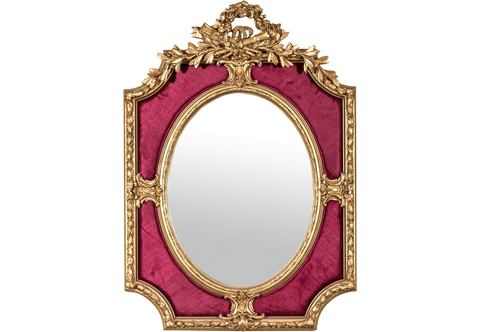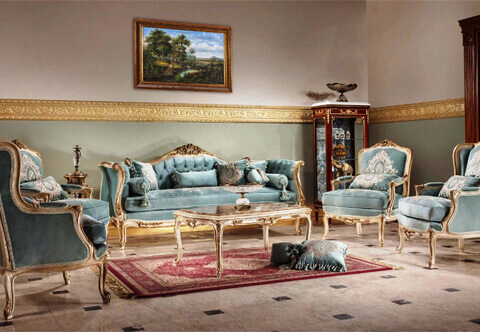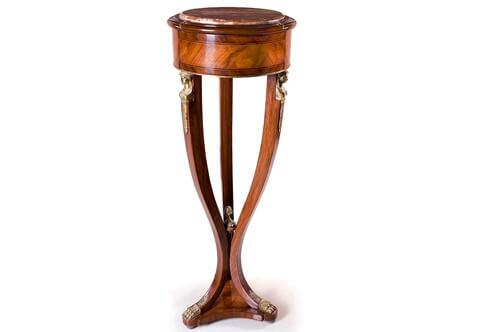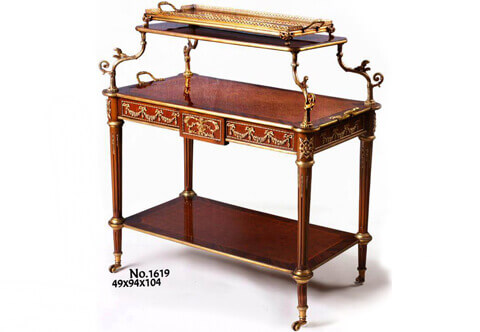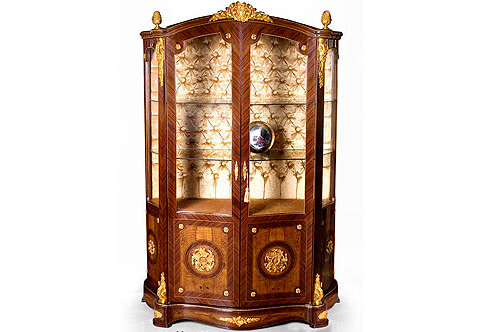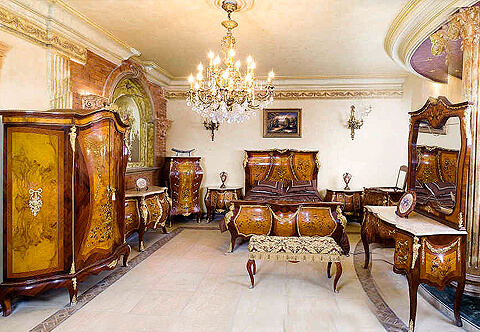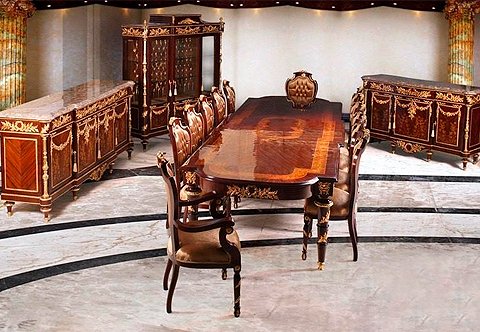French Louis XVI late Rococo and Vernis Martin Renaissance style white lacquered ormolu-mounted hand carved, hand painted and French foil gilded grand Bust Pedestals
Ref#ST-3726-R | Description
A royal and extremely stunning pair of French Louis XVI late Rococo and Vernis Martin Renaissance style ormolu-mounted white lacquered hand carved and French foil gilded grand Bust Pedestals;
The square veined and mottled marble top rests above a fabulously hand carved concaved sides neck adorned with Egg and Cyma Recta bands, large scrolling acanthus leaves volutes and acanthus foliate bouquet above a laurel wreath astragal;
The tapering body below is white lacquered and exquisitely hand painted in Vernis Martin style with landscape and renaissance style mythological scenes depicting nymphs engaged with cupid and cherubs and enframed within a hammered ormolu band and surmounted with a finely chiseled ormolu mount of a cartouche issuing scrolling swaging bay leaf garlands; Frets of Greek keys and blossoming acanthus leaves; the lower part is ornamented with an ormolu encadrement of large scrolling Acanthus Mollis on an Egg trim;
The lower plinth is white lacquered and surmounted with a leveled carved and French foil gilded frieze of different architectural decorative patterns and hand painted with playful cherubs and colorful flower bouquets enframed within a hammered ormolu band; all above the gilded topie shaped feet.
Ref#ST-3726-R
H:129 x W:40 x D:40cm
Louis XVI Style | Late Rococo style
Vernis Martin Style | Renaissance style
Late Rococo Style
Louis XVI style, also spelled Louis Seize, visual arts produced in France during the reign (1774–93) of Louis XVI, which was actually both a last phase of Rococo and a first phase of Neoclassicism. The predominant style in architecture, painting, sculpture, and the decorative arts was Neoclassicism, a style that had come into its own during the last years of Louis XV’s life, chiefly as a reaction to the excesses of the Rococo but partly through the popularity of the excavations at ancient Herculaneum and Pompeii, in Italy, and partly on the basis of Jean-Jacques Rousseau’s call for “natural” virtue and honest sentiment. One of the most dramatic episodes in the stylistic oscillation from Rococo to Neoclassicism was played out in 1770 at Mme du Barry’s Pavillon de Louveciennes. A series of large painted canvases by the Rococo painter Jean-Honoré Fragonard depicting the “Progress of Love” were removed almost as soon as they were installed and replaced with a series commissioned from Joseph-Marie Vien, a Neoclassicist. Vien’s pupil Jacques-Louis David was the most important painter of the reign of Louis XVI; his severe compositions recalling the style of the earlier painter Nicolas Poussin are documents extolling republican virtues. During the Revolution, David was a deputy and voted for the execution of the King.
The foremost sculptor of the reign of Louis XVI was Jean-Antoine Houdon (1741–1828). He portrayed a number of the most prominent men of his day, often in classical togas. His nude “Diana,” of which there are several versions, attempts to evoke the feeling of the Classical Greek nude.
The lavish court style of Louis and Marie Antoinette, his young queen, gave impetus to the highly skilled ébénistes, or cabinetmakers, of the period. Whereas the general style of furniture was again Neoclassic (i.e., straight, simple lines and classical motifs), the workmanship was as complicated and as finely performed as in any period to date. Jean-Henri Riesener and Bernard van Risenburgh were two of the foremost cabinetmakers, filling commissions for Mme du Barry as well as for the Queen. Many of the ébénistes, including Riesener, were German craftsmen who, nevertheless, contributed to the tradition of French furniture. Other makers of luxury items benefited from the excesses of the court, chief among them the porcelain manufactory at Sèvres.[Britannica].
Vernis Martin
A generic name, derived from a distinguished family of French artist-artificers of the 18th century, given to a brilliant translucent lacquer extensively used in the decoration of furniture, carriages, sedan chairs and a multitude of small articles such as snuff-boxes and fans. There were four brothers of the Martin family: Guillaume (d. 1749), Simon Etienne, Julien and Robert (1706-1765), the two first-named being the elder. They were the children of Etienne Martin, a tailor, and began life as coach-painters.
They neither invented, nor claimed to have invented, the varnish which bears their name, but they enormously improved, and eventually brought to perfection, compositions and methods of applying them which were already more or less familiar. Oriental lacquer speedily acquired high favour in France, and many attempts were made to imitate it. Some of these attempts were pass ably successful, and we can hardly doubt that many of the examples in the possession of Louis XIV. at his death were of European manufacture. Chinese lacquer was, however, imported in large quantities, and sometimes panels were made in China from designs prepared in Paris, just as English coats of arms were placed upon Chinese porcelain in its place of origin. Biographical details of the career of the brothers Martin are scanty, but we know that the eldest was already in business in 1724. Their method and work must have come rapidly into vogue, for in 1730 Guillaume and Simon Etienne Martin were granted by letters patent a twenty years' monopoly, subsequently renewed, of making "toutes sortes d'ouvrages en relief de la Chine et du Japon."
At the height of their fame the brothers directed at least three factories in Paris, and in 1748 they were all classed together as a "Manufacture nationale." One of them was still in existence in 1785. The literature of their day had much to say of the freres Martin. In Voltaire's comedy of Nadine, produced in 1749, mention is made of a berline " bonne et brillante, tous les panneaux par Martin sont vernis"; also in his Premier discours sur l'inegalite des conditions he speaks of "des lambris dores et vernis par Martin." The marquis de Mirabeau in L'Ami des hommes refers to the enamelled snuff-boxes and varnished carriages which came from the Martins' factory. It is the fate of all the great artists of the past to have had their names attached, by popular rumour or interested artifice, to a multitude of works which they never saw, and the Martins have suffered considerably in this respect. That the quality of their production varied between very wide limits is established by existing and undoubted examples; but it is extremely improbable that even their three factories could have turned out the infinite quantity of examples that has been attributed to them.
Yet their production was large and exceedingly miscellaneous, for such was the rage for their lacquer that it was applied to every possible object. Nor need we be surprised at a rage which was by no means confined to France. At its best `l,ernis Martin has a splendour of sheen, a perfection of polish, a beauty of translucence which compel the admiration due to a consummate specimen of handiwork. Every variety of the lacquer of the Far East was imitated and often improved upon by the Martins - the black with raised gold ornaments, the red, and finally in the wonderful green ground, powdered with gold, they reached the high-water mark of their delightful art. This delicate work, poudré and wavy-lined with gold or seine with flowers overlaid with transparent enamel, is seen at its best on small boxes, fans, needle-cases and such-like. Of the larger specimens from the Martins' factories a vast quantity has disappeared, or been cut up into decorative panels.
It would appear that none of the work they placed in the famous hotels of old Paris is now in situ, and it is to museums that we must go for really fine examples - to the Musee de Cluny for an exquisite children's sedan chair and the coach used by the French ambassador to Venice under Louis XV.; to the Wallace collection for the tables with richly chased mounts that have been attributed to Dubois; to Fontainebleau for a famous commode. Even the decorations of the apartments of the dauphin at Versailles, executed, or at least begun, in 1749, have vanished; so have those at Bellevue. It has been generally accepted that of the four brothers Robert Martin accomplished the most original and the most completely artistic work. He left a son, Jean Alexandre, who described himself in 1767 as "Vernisseur du Roi de Prusse." He was employed at Sans Souci, but failed to continue the great traditions of his father and his uncles. The Revolution finally extinguished a taste which had lasted for a large part of the 18th century. Since then the production of lacquer has, on the whole, been an industry rather than an art. (J. P.-B.)

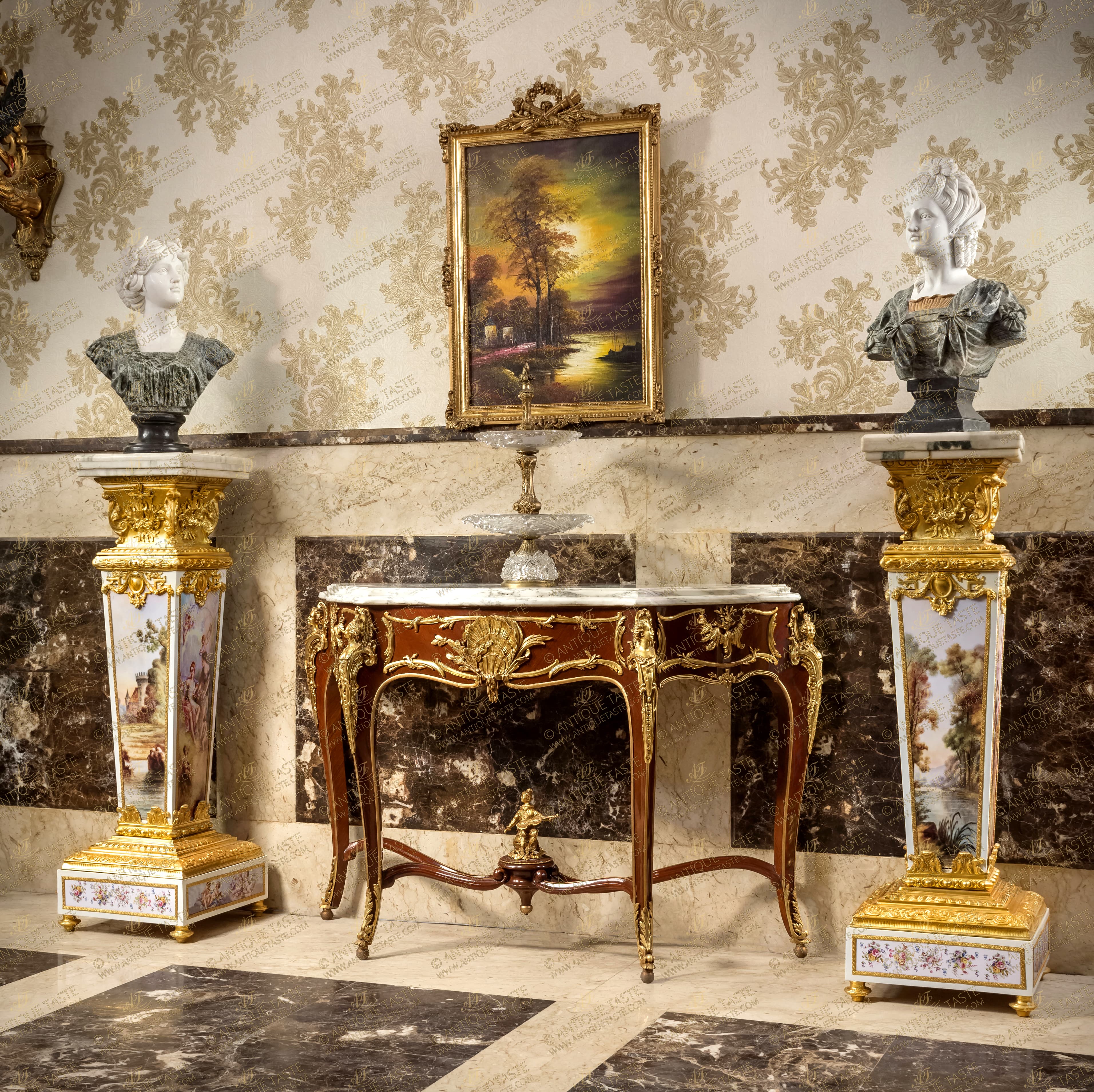
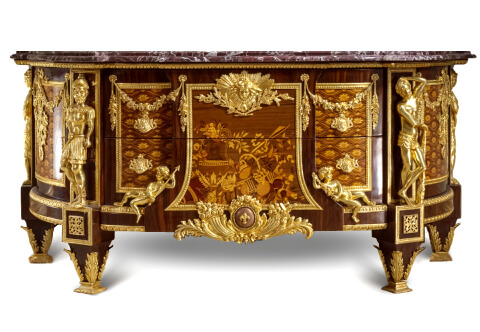
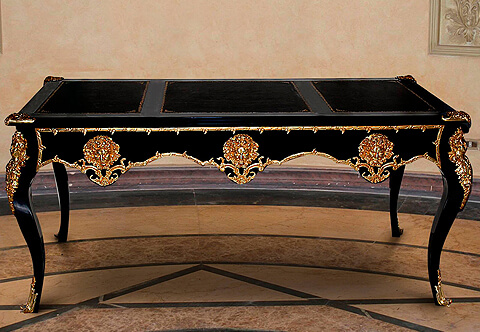
.jpg)
